| Pilgrim Places
| |||||
It is believed that the temple of Kedarnath was built 5000 years ago by the Pandavas. At a height of 3600 m, it closes on Diwali in Oct/Nov to open again for Akshay Tritiya in April. There are several options of offering Pujas or rituals at the Kedarnath temple. I was told about the Abhisheka Puja and it was as rewarding as I had been told it would be. At 5 am there were no crowds milling the temple and I could pray to my heart's content in privacy. Having visited Kedarnath both in the summer and in early October, I would personally recommend the latter season. |
More on Uttarakhand • Badrinath • Haridwar • Rishikesh • Char Dham
Impressions
Pilgrimages
Trekking
Photo Gallery | ||||
Legend has it, that after the great battle of Mahabharata, the Pandavas performed penance to absolve themselves of the sins of killing their own kith and kin. They tried to appease Brahma and Vishnu in succession, who realising the severity of the penance they themselves would have to perform to help the Pandavas, referred them in turn to Ashutosh/Shiva. Shiva remained unmoved. As the Pandavas performed rigorous penance, Shiva hid from them till he was cornered in the Himalayas. Finding a herd of cattle grazing in the marshy Kedar, he turned himself into a bull and mingled with the herd.
At Kedar the Shiva linga is shaped like a bull's hump. Following Bhima's example devotees offer worship by trying to grab the deity with both hands. This is the foremost among the Swayambhu Jyotirlingas, which are natural and not man-made. The bull's body parts appeared at 4 other mountains and over each the Pandavas built a temple. The forelegs and heart appeared at Tunganath, the navel at Madhyamaheshwar, part of the face at Rudranath and his matted locks or Jata at Kalpeshwar. A pilgrimage to all 5 is called Panch Kedar Yatra.
Shankaracharya took mahasamadhi at a beautiful spot behind this temple on the banks of the Mandakini. A small temple with his statue and the Shivalinga worshipped by him are there. Between these two temples is a patch of verdant green in sharp contrast to the stark mountains behind, divided by a marble wall with the symbolic presence of Shankara's hand holding the Sanyasi's staff. Several small streams converge to form the mighty Mandakini, which flows quietly beside the temple, in seeming respect. Beyond stands the sheer, almost vertical Kedarnath peak, pristine in its whiteness, head amidst the clouds.
Om Namoh Shivay. Photo Credit: Biswarup Mukherjee Kedarnath Yatra ~ Biswarup Mukherjee
|
|||||
Editor: Romola Butalia (c) India Travelogue. All rights reserved. |
|||||
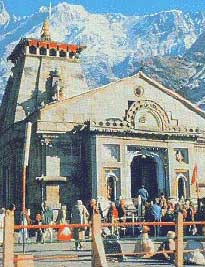 At the foot of the Kedarnath mountain, which stands imposingly with its icy peaks as silent sentinels, is the temple of Kedarnath. I was acutely aware of the minuteness of the individual and awed by the stories of those who stay here throughout the year, in meditation. I visited the samadhi of Phalahari Baba in symbolic respect of the meditating sages.
At the foot of the Kedarnath mountain, which stands imposingly with its icy peaks as silent sentinels, is the temple of Kedarnath. I was acutely aware of the minuteness of the individual and awed by the stories of those who stay here throughout the year, in meditation. I visited the samadhi of Phalahari Baba in symbolic respect of the meditating sages. 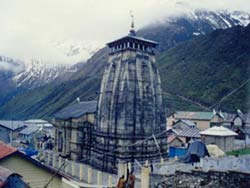 The structure of the temple is much like other temples in Uttaranchal. There is a large Nandi facing the main entrance. Inside the temple is a rectangular space with railings around it. All along the wall there are niches in which there are idols of the Pancha Pandavas, Parvati, Lakshmi & Narada. A small archway and a short flight of stairs lead to the deity. The method of worshipping is also unique. One is supposed to try to grab the large conical stone with both hands and embrace it. It is cold and damp in the confined space and during darshan time there is a fervent rush to embrace this Ashutosh linga . Outside at the north-east corner is a small temple of Ishaneshwar Mahadev.
The structure of the temple is much like other temples in Uttaranchal. There is a large Nandi facing the main entrance. Inside the temple is a rectangular space with railings around it. All along the wall there are niches in which there are idols of the Pancha Pandavas, Parvati, Lakshmi & Narada. A small archway and a short flight of stairs lead to the deity. The method of worshipping is also unique. One is supposed to try to grab the large conical stone with both hands and embrace it. It is cold and damp in the confined space and during darshan time there is a fervent rush to embrace this Ashutosh linga . Outside at the north-east corner is a small temple of Ishaneshwar Mahadev.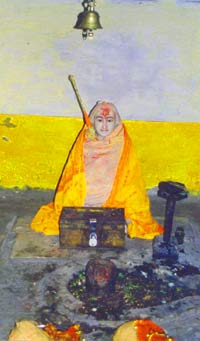 The Pandavas were at a loss, until Narada Muni suggested that Bhima stand with his feet on two adjoining mountains and the other four Pandavas round up the cattle and drive them through the valley straddled by Bhima. The sage Narada, with his usual strategising, realised that all the cattle would pass under Bhima's extended legs, except the bull who was Shiva in disguise. The Pandavas found a solitary bull refusing to follow the herd. They ran after him and corralled him. Shiva started digging the soft earth and as he descended underground, Bhima caught hold of the bull's hump. At last, seeing their perseverance, Shiva relented and give darshan to the Pandavas.
The Pandavas were at a loss, until Narada Muni suggested that Bhima stand with his feet on two adjoining mountains and the other four Pandavas round up the cattle and drive them through the valley straddled by Bhima. The sage Narada, with his usual strategising, realised that all the cattle would pass under Bhima's extended legs, except the bull who was Shiva in disguise. The Pandavas found a solitary bull refusing to follow the herd. They ran after him and corralled him. Shiva started digging the soft earth and as he descended underground, Bhima caught hold of the bull's hump. At last, seeing their perseverance, Shiva relented and give darshan to the Pandavas. 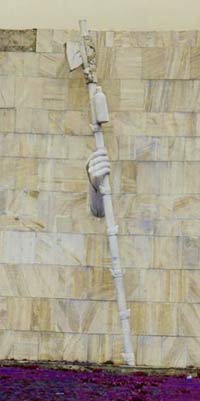 True to this legend there are statues of all 5 Pandavas in cornices in the temple. There are also the statues of Siva's consort Parvati, Vishnu's consort Lakshmi and the sage Narada. Kedarnath had fallen into ruins till Adiguru Shankaracharya revived it and initiated systematic worship and maintenance here. He allotted the responsibility to several of his disciples who had accompanied him. To this day, Kedarnath temple has a Nambudiripad Brahmin from Kerala as its chief priest/Rawal.
True to this legend there are statues of all 5 Pandavas in cornices in the temple. There are also the statues of Siva's consort Parvati, Vishnu's consort Lakshmi and the sage Narada. Kedarnath had fallen into ruins till Adiguru Shankaracharya revived it and initiated systematic worship and maintenance here. He allotted the responsibility to several of his disciples who had accompanied him. To this day, Kedarnath temple has a Nambudiripad Brahmin from Kerala as its chief priest/Rawal.
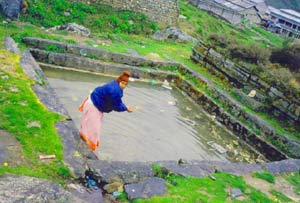 Apart from these temples there are several natural springs/Kundas. The one within the temple quadrangle is called Brahma Kunda. At the front of the temple, by the main road is the Udak Kund. It is believed that a sip of water here will prevent accidental death. Pilgrims perform tarpan at the Hamsa Kund to the right of the main temple. On the way to the Bhairavnath temple is Retas Kund, protected by a stone structure. Bubbles are expressed in this small stream at the sound of clapping or the frequently expressed chants to Shiva. From Kedarnath one can trek to Chorabali Tal, also known as Gandhi Sarovar. One can also trek 6 kms on a treacherous path to Vasuki Tal from where Brahmakamal is collected during the rainy season of August -September to worship Lord Shiva.
Apart from these temples there are several natural springs/Kundas. The one within the temple quadrangle is called Brahma Kunda. At the front of the temple, by the main road is the Udak Kund. It is believed that a sip of water here will prevent accidental death. Pilgrims perform tarpan at the Hamsa Kund to the right of the main temple. On the way to the Bhairavnath temple is Retas Kund, protected by a stone structure. Bubbles are expressed in this small stream at the sound of clapping or the frequently expressed chants to Shiva. From Kedarnath one can trek to Chorabali Tal, also known as Gandhi Sarovar. One can also trek 6 kms on a treacherous path to Vasuki Tal from where Brahmakamal is collected during the rainy season of August -September to worship Lord Shiva.